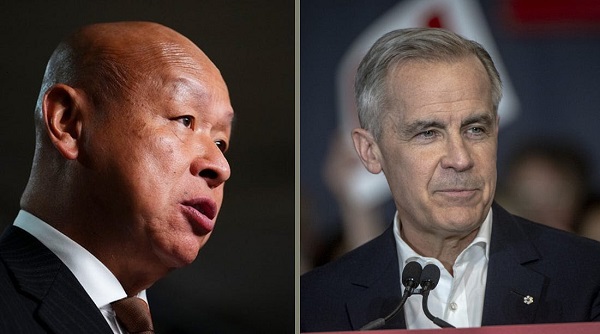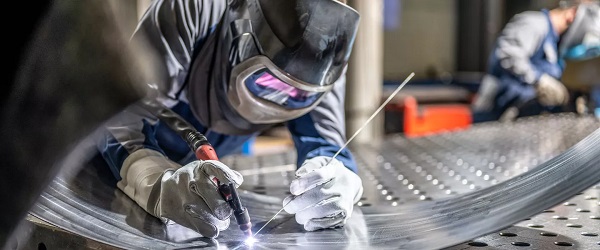Alberta
COASTAL GASLINK PIPELINE PROJECT SETS NEW STANDARD WITH UNPRECEDENTED INDIGENOUS SUPPORT AND PARTICIPATION

COASTAL GASLINK PIPELINE PROJECT SETS NEW STANDARD WITH UNPRECEDENTED INDIGENOUS SUPPORT AND PARTICIPATION
Coastal GasLink (CGL) is a 670-kilometre pipeline that will deliver natural gas from northeastern British Columbia to LNG Canada’s export terminal in Kitimat, B.C. As part of Coastal GasLink’s commitment to ensuring Indigenous and local communities are able to fully benefit from the construction and operation of the pipeline, we successfully negotiated 20 project and community agreements that clearly demonstrate our commitment to their communities for the long-term.
The Coastal GasLink Pipeline Project has set a new standard for Indigenous engagement and participation in critical energy infrastructure project development and construction. Since the project was first announced in 2012, thousands of hours have gone into listening and collaborating with Indigenous and local communities to create a project that is delivering on environmental and cultural protection, including $1-billion in long-term economic benefits through jobs and contracting opportunities.
“Integrity, collaboration and respect are at the heart of Coastal GasLink’s commitment to creating lasting opportunities for Indigenous communities in northern British Columbia and we’re proud of the relationships we’ve built,” said Tiffany Murray, Coastal GasLink’s director of Indigenous Relations.
“There is unprecedented support for this pipeline project from Indigenous and local communities, including agreements with the 20 elected First Nations along the right of way. Our engagement started at the early conceptual phase and continues today,” added Murray. “We are committed to engaging and working collaboratively on the project as it moves through construction and into operations.”
Coastal GasLink is a 670-kilometre pipeline that will safely deliver natural gas from northeastern B.C. to the LNG Canada liquefaction facility in Kitimat, B.C., connecting clean, sustainability produced Canadian energy to the world and ultimately, playing a critical role in the reduction of global greenhouse gas emissions and air pollution in Asia.
Construction launched in early 2019 following more than six years of rigorous review and environmental assessment. From the beginning, the project team focused on building relationships based on mutual trust and respect by providing meaningful opportunities for participation in project planning and jobs and local contracting prospects for Indigenous and local businesses and their communities.

Photo provided courtesy of TC Energy. Coastal GasLink implemented a Construction Monitoring and Community Liaison Program (CMCL). It provides opportunities for Indigenous members to participate in construction within their traditional territory for the purposes of observing, recording and reporting on implementation of construction activities to their communities.
A milestone moment was marked in June 2018 when leadership from a number of Indigenous groups and Coastal GasLink celebrated the announcement of the commitment for $620 million in contract awards to northern British Columbia Indigenous businesses for the project’s right- of-way clearing, medical, security and workforce accommodations. To date, Coastal GasLink has exceeded its commitments and awarded approximately $720 million in contracts to Indigenous and local businesses.
More than one-third of the field work completed on the project was conducted by Indigenous people and traditional knowledge was considered in its planning and design. The project continues to prioritize Indigenous and local hiring and held 25 Economic Summits along the route in 2018 and 2019 to connect interested job seekers and businesses with potential opportunities. Additionally, a variety of training programs continue to support Indigenous and local trainees and students. To protect Indigenous culture and values along with the environment during project construction, a Construction Monitoring and Community Liaison Program (CMCL) has been launched. The program provides opportunities for Indigenous community members to participate in construction within their traditional territory for the purposes of observing, recording and reporting on implementation of construction activities to their communities. It will continue through construction of the pipeline, which is planned for in-service in 2023.

Photo provided courtesy of TC Energy. Skills training and education is an essential part of Coastal GasLink’s committee to creating an extraordinary legacy. TC Energy invests in skills development and long-term education programs to support Indigenous and local residents and trainees.
Transparency is core to the CMCL program with Indigenous communities by meaningfully participating in the project to monitor the work that is being done. That open, relationship-based approach is something that Coastal GasLink believes is integral to the success of the projec
Harry Bodewitz, a program coordinator who is working closely with CMCL advisors from several Indigenous communities along the project corridor, has seen the value of the program. As construction ramps up, additional CMCL advisors will be brought on to be involved in the program.
“Something might have been planned initially, but once we actually get to the field, that plan may change, or get modified, to make sure it’s done right,” said Bodewitz. “In the CMCL Program, we have an opportunity to observe what’s going on, discuss it and share that with our communities.”
For Mike Gouchie, a CMCL coordinator from Lheidli T’enneh First Nation, the program provides a chance to be out in the field to make sure what matters to his community and neighbouring community CMCL advisors, is at the forefront of the construction program.
“As a CMCL coordinator, I’m able to assist the CMCL advisors to be out in the field with inspectors, construction management and myself to visit sites of interest, to understand the scope of the project in our territories and make sure environmental issues are identified,” he said.
Whether it’s in the field or at the table with First Nation leaders for monthly meetings, Coastal GasLink has involved Indigenous communities every step of the way.

Photo provided courtesy of TC Energy. Coastal GasLink is delivering significant economic benefits to British Columbian families today and for decades to come.
“I’m proud of the relationships we have built and the work we’ve done on this project,” said Murray.
“We believe that by building meaningful, long-term relationships based on trust and integrating feedback into our project, we will create an extraordinary legacy of safety and respect for communities and the environment.”
Background: The Canadian Energy Compendium is an annual Energy Council of Canada initiative which provides opportunity for cross-sectoral collaboration on a topic of shared interest across the Canadian energy sector, produced with the support of Canada’s national energy associations and Energy Council of Canada’s members. The stories contributed to the 2019 edition, Indigenous Energy Across Canada, highlight current conversations celebrating Canada’s dynamic energy sector and encouraging its continuous improvement.
Thanks to Todayville for helping us bring our members’ stories of collaboration and innovation to the public.
Click to read a Foreward from JP Gladu, Chief Development and Relations Officer, Steel River Group; Former President & CEO, Canadian Council for Aboriginal Business

JP Gladu, Chief Development and Relations Officer, Steel
River Group; Former President & CEO, Canadian Council for Aboriginal Business

Jacob Irving, President of Energy Council of Canada
The Canadian Energy Compendium is an annual initiative by the Energy Council of Canada to provide an opportunity for cross-sectoral collaboration and discussion on current topics in Canada’s energy sector. The 2020 Canadian Energy Compendium: Innovations in Energy Efficiency is due to be released November 2020.
Click to read comments about this series from Jacob Irving, President of the Energy Council of Canada.
2025 Federal Election
Next federal government should recognize Alberta’s important role in the federation

From the Fraser Institute
By Tegan Hill
With the tariff war continuing and the federal election underway, Canadians should understand what the last federal government seemingly did not—a strong Alberta makes for a stronger Canada.
And yet, current federal policies disproportionately and negatively impact the province. The list includes Bill C-69 (which imposes complex, uncertain and onerous review requirements on major energy projects), Bill C-48 (which bans large oil tankers off British Columbia’s northern coast and limits access to Asian markets), an arbitrary cap on oil and gas emissions, numerous other “net-zero” targets, and so on.
Meanwhile, Albertans contribute significantly more to federal revenues and national programs than they receive back in spending on transfers and programs including the Canada Pension Plan (CPP) because Alberta has relatively high rates of employment, higher average incomes and a younger population.
For instance, since 1976 Alberta’s employment rate (the number of employed people as a share of the population 15 years of age and over) has averaged 67.4 per cent compared to 59.7 per cent in the rest of Canada, and annual market income (including employment and investment income) has exceeded that in the other provinces by $10,918 (on average).
As a result, Alberta’s total net contribution to federal finances (total federal taxes and payments paid by Albertans minus federal money spent or transferred to Albertans) was $244.6 billion from 2007 to 2022—more than five times as much as the net contribution from British Columbians or Ontarians. That’s a massive outsized contribution given Alberta’s population, which is smaller than B.C. and much smaller than Ontario.
Albertans’ net contribution to the CPP is particularly significant. From 1981 to 2022, Alberta workers contributed 14.4 per cent (on average) of total CPP payments paid to retirees in Canada while retirees in the province received only 10.0 per cent of the payments. Albertans made a cumulative net contribution to the CPP (the difference between total CPP contributions made by Albertans and CPP benefits paid to retirees in Alberta) of $53.6 billion over the period—approximately six times greater than the net contribution of B.C., the only other net contributing province to the CPP. Indeed, only two of the nine provinces that participate in the CPP contribute more in payroll taxes to the program than their residents receive back in benefits.
So what would happen if Alberta withdrew from the CPP?
For starters, the basic CPP contribution rate of 9.9 per cent (typically deducted from our paycheques) for Canadians outside Alberta (excluding Quebec) would have to increase for the program to remain sustainable. For a new standalone plan in Alberta, the rate would likely be lower, with estimates ranging from 5.85 per cent to 8.2 per cent. In other words, based on these estimates, if Alberta withdrew from the CPP, Alberta workers could receive the same retirement benefits but at a lower cost (i.e. lower payroll tax) than other Canadians while the payroll tax would have to increase for the rest of the country while the benefits remained the same.
Finally, despite any claims to the contrary, according to Statistics Canada, Alberta’s demographic advantage, which fuels its outsized contribution to the CPP, will only widen in the years ahead. Alberta will likely maintain relatively high employment rates and continue to welcome workers from across Canada and around the world. And considering Alberta recorded the highest average inflation-adjusted economic growth in Canada since 1981, with Albertans’ inflation-adjusted market income exceeding the average of the other provinces every year since 1971, Albertans will likely continue to pay an outsized portion for the CPP. Of course, the idea for Alberta to withdraw from the CPP and create its own provincial plan isn’t new. In 2001, several notable public figures, including Stephen Harper, wrote the famous Alberta “firewall” letter suggesting the province should take control of its future after being marginalized by the federal government.
The next federal government—whoever that may be—should understand Alberta’s crucial role in the federation. For a stronger Canada, especially during uncertain times, Ottawa should support a strong Alberta including its energy industry.
Alberta
Province announces plans for nine new ‘urgent care centres’ – redirecting 200,000 hospital visits

Expanding urgent care across Alberta
If passed, Budget 2025 includes $17 million in planning funds to support the development of urgent care facilities across the province.
As Alberta’s population grows, so does the demand for health care. In response, the government is making significant investments to ensure every Albertan has access to high-quality care close to home. Currently, more than 35 per cent of emergency department visits are for non-life-threatening conditions that could be treated at urgent care centres. By expanding these centres, Alberta’s government is enhancing the health care system and improving access to timely care.
If passed, Budget 2025 includes $15 million to support plans for eight new urgent care centres and an additional $2 million in planning funds for an integrated primary and urgent care facility in Airdrie. These investments will help redirect up to 200,000 lower-acuity emergency department visits annually, freeing up capacity for life-threatening cases, reducing wait times and improving access to care for Albertans.
“More people are choosing to call Alberta home, which is why we are taking action to build capacity across the health care system. Urgent care centres help bridge the gap between primary care and emergency departments, providing timely care for non-life-threatening conditions.”
“Our team at Infrastructure is fully committed to leading the important task of planning these eight new urgent care facilities across the province. Investments into facilities like these help strengthen our communities by alleviating strains on emergency departments and enhance access to care. I am looking forward to the important work ahead.”
The locations for the eight new urgent care centres were selected based on current and projected increases in demand for lower-acuity care at emergency departments. The new facilities will be in west Edmonton, south Edmonton, Westview (Stony Plain/Spruce Grove), east Calgary, Lethbridge, Medicine Hat, Cold Lake and Fort McMurray.
“Too many Albertans, especially those living in rural communities, are travelling significant distances to receive care. Advancing plans for new urgent care centres will build capacity across the health care system.”
“Additional urgent care centres across Alberta will give Albertans more options for accessing the right level of care when it’s needed. This is a necessary and substantial investment that will eventually ease some of the pressures on our emergency departments.”
The remaining $2 million will support planning for One Health Airdrie’s integrated primary and urgent care facility. The operating model, approved last fall, will see One Health Airdrie as the primary care operator, while urgent care services will be publicly funded and operated by a provider selected through a competitive process.
“Our new Airdrie facility, offering integrated primary and urgent care, will provide same-day access to approximately 30,000 primary care patients and increase urgent care capacity by around 200 per cent, benefiting the entire community and surrounding areas. We are very excited.”
Alberta’s government will continue to make smart, strategic investments in health facilities to support the delivery of publicly funded health programs and services to ensure Albertans have access to the care they need, when and where they need it.
Budget 2025 is meeting the challenge faced by Alberta with continued investments in education and health, lower taxes for families and a focus on the economy.
Quick facts
- The $2 million in planning funds for One Health Airdrie are part of a total $24-million investment to advance planning on several health capital initiatives across the province through Budget 2025.
- Alberta’s population is growing, and visits to emergency departments are projected to increase by 27 per cent by 2038.
- Last year, Alberta’s government provided $8.4 million for renovations to the existing Airdrie Community Health Centre.
Related information
-

 Uncategorized22 hours ago
Uncategorized22 hours agoPoilievre on 2025 Election Interference – Carney sill hasn’t fired Liberal MP in Chinese election interference scandal
-

 Business1 day ago
Business1 day agoCuba has lost 24% of it’s population to emigration in the last 4 years
-

 2025 Federal Election23 hours ago
2025 Federal Election23 hours ago2025 Election Interference – CCP Bounty on Conservative Candidate – Carney Says Nothing
-

 Business2 days ago
Business2 days agoTariff-driven increase of U.S. manufacturing investment would face dearth of workers
-

 2025 Federal Election9 hours ago
2025 Federal Election9 hours agoChinese Election Interference – NDP reaction to bounty on Conservative candidate
-

 2025 Federal Election23 hours ago
2025 Federal Election23 hours ago2025 Federal Election Interference from China! Carney Pressed to Remove Liberal MP Over CCP Bounty Remark
-

 International1 day ago
International1 day agoTrump signs executive order to make Washington D.C. “safe and beautiful”
-

 Education2 days ago
Education2 days agoOur Kids Are Struggling To Read. Phonics Is The Easy Fix




